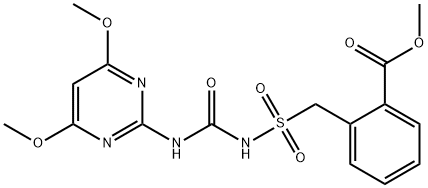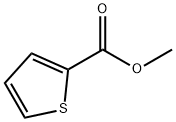Methyl thiocyanate
Synonym(s):Thiocyanic acid methyl ester
- CAS NO.:556-64-9
- Empirical Formula: C2H3NS
- Molecular Weight: 73.12
- MDL number: MFCD00001830
- EINECS: 209-134-6
- SAFETY DATA SHEET (SDS)
- Update Date: 2024-12-18 14:15:32

What is Methyl thiocyanate?
Description
Methyl thiocyanate is a colorless liquid withan onion-like odor. Molecular weight = 73.12; Boilingpoint= 130-133℃; Freezing/Melting point= - 51℃.Very slightly soluble in water.
Chemical properties
CLEAR COLOURLESS TO LIGHT YELLOW LIQUID
Chemical properties
Methyl thiocyanate is a colorless liquid. Onion-like odor
The Uses of Methyl thiocyanate
Methyl thiocyanate is a reagent that is used in the synthesis of WAK 4103 (W498200), which is a metabolite of Imidacloprid (I274990), a neonicotinoid; the active ingredient in certain neuro-active insecticides. Reports show that when exposed to neonicotinid pesticides honeybees have probelms returnign home after foraging and bumblebee colonies grow poorly and produce fewer queens.Nauen, R., et. al.: Pestic. Sci., 55, 265 (1999); Chauzat, M., et al.: Env. Entomol., 38, 514 (2009); Patial, A., et al.: Env. Ecol., 27, 320 (2009); Fernandez-Bayo, J., et al.: J. Agric., Food Chem., 57, 5435 (2009); Tomizawa, M., et al.: J. Med. Chem., 52, 3735 (2009); Chem. and Eng. News 90: 10 (2012)
Definition
ChEBI: Methyl thiocyanate is a member of the class of thiocyanates, being the methyl ester of thiocyanic acid.
General Description
Colorless liquid and an odor of onions. Used as an agricultural insecticide, a fumigant and as a research chemical. No evidence of commercial production in the U.S.
Air & Water Reactions
Very slightly soluble in water [Merck].
Reactivity Profile
Methyl thiocyanate is a moderately toxic liquid, flammable. Violent, possibly explosive oxidation reaction when mixed with chlorates, nitrates, nitric acid, organic or inorganic peroxides, perchlorates. On contact with mineral acids or acid fumes deadly toxic hydrogen cyanide gas is produced. When heated to decomposition or on contact with mineral acids Methyl thiocyanate emits highly toxic fumes of nitriles, oxides of sulfur and nitrogen [Lewis, 3rd ed., 1993, p. 879, 1234].
Health Hazard
Methyl thiocyanate is highly toxic if ingested. It is a rapidly acting poison.
Fire Hazard
When heated to decomposition, Methyl thiocyanate emits very toxic fumes of oxides of nitrogen and sulfur. (Non-Specific -- Thiocyanates) Incompatible with nitric acid. Violent reactions have occurred when mixed with chlorates, nitrates, nitric acid, organic peroxides, peroxides, potassium chlorate, and sodium chlorate. Methyl thiocyanate is volatile.
Safety Profile
Poison by ingestion, intravenous, and subcutaneous routes. When heated to decomposition it emits very toxic fumes of NOx and SOx.
Potential Exposure
It is used as an agricultural insecticide; a fumigant; and as a research chemical. No evidence of commercial production in the United States.
First aid
If this chemical gets into the eyes, remove anycontact lenses at once and irrigate immediately for at least15 min, occasionally lifting upper and lower lids. Seek medical attention immediately. If this chemical contacts theskin, remove contaminated clothing and wash immediatelywith soap and water. Seek medical attention immediately. Ifthis chemical has been inhaled, remove from exposure,begin rescue breathing (using universal precautions, including resuscitation mask) if breathing has stopped and CPR ifheart action has stopped. Transfer promptly to a medicalfacility. When this chemical has been swallowed, get medical attention. Give large quantities of water and inducevomiting. Do not make an unconscious person vomit.Note: Because cyanide is probably largely responsible forpoisonings, antidotal measures against cyanide should beinstituted promptly. Use amyl nitrate capsules if symptomsdevelop. All area employees should be trained regularly inemergency measures for cyanide poisoning and in CPR. Acyanide antidote kit should be kept in the immediate workarea and must be rapidly available. Kit ingredients shouldbe replaced every 1- 2 years to ensure freshness. Personstrained in the use of this kit, oxygen use, and CPR must bequickly available.
storage
Color Code—Blue: Health Hazard/Poison: Storein a secure poison location. Prior to working with thischemical you should be trained on its proper handling andstorage. Store in tightly closed containers in a cool, wellventilated area away from oxidizers. Where possible, automatically pump liquid from drums or other storage containers to process containers.
Shipping
UN2929 Toxic liquids, flammable, organic, n.o.s., Hazard class: 6.1; Labels: 6.1-Poison Inhalation Hazard, 3-Flammable liquid, Technical Name Required. UN1992 Flammable liquids, toxic, n.o.s., Hazard Class: 3; Labels: 3-Flammable liquid, 6.1-Poisonous materials, Technical Name Required.
Incompatibilities
Incompatible with nitric acid. Violent reactions have occurred when mixed with chlorates, nitrates, nitric acid; peroxides, potassium chlorate; and sodium chlorate.
Properties of Methyl thiocyanate
| Melting point: | -5 °C |
| Boiling point: | 131 °C |
| Density | 1.08 |
| refractive index | 1.467-1.469 |
| Flash point: | 38 °C |
| storage temp. | Poison room |
| Water Solubility | Practically insoluble in water |
| solubility | Chloroform (Soluble), Methanol (Slightly) |
| form | Liquid |
| color | Clear colorless to light yellow |
| Odor | at 0.01?%?in?propylene glycol. sulfury onion |
| Sensitive | Moisture Sensitive |
| Merck | 14,6127 |
| Dielectric constant | 4.3(19℃) |
| CAS DataBase Reference | 556-64-9(CAS DataBase Reference) |
| NIST Chemistry Reference | Thiocyanic acid, methyl ester(556-64-9) |
| EPA Substance Registry System | Methyl thiocyanate (556-64-9) |
Safety information for Methyl thiocyanate
| Signal word | Danger |
| Pictogram(s) |
 Flame Flammables GHS02  Skull and Crossbones Acute Toxicity GHS06 |
| GHS Hazard Statements |
H226:Flammable liquids H319:Serious eye damage/eye irritation H335:Specific target organ toxicity, single exposure;Respiratory tract irritation |
| Precautionary Statement Codes |
P210:Keep away from heat/sparks/open flames/hot surfaces. — No smoking. P280:Wear protective gloves/protective clothing/eye protection/face protection. P301+P310:IF SWALLOWED: Immediately call a POISON CENTER or doctor/physician. P303+P361+P353:IF ON SKIN (or hair): Remove/Take off Immediately all contaminated clothing. Rinse SKIN with water/shower. P305+P351+P338:IF IN EYES: Rinse cautiously with water for several minutes. Remove contact lenses, if present and easy to do. Continuerinsing. |
Computed Descriptors for Methyl thiocyanate
New Products
Tert-butyl bis(2-chloroethyl)carbamate (S)-3-Aminobutanenitrile hydrochloride N-Boc-D-alaninol N-BOC-D/L-ALANINOL 3-(2,4-Dimethoxybenzyl)dihydropyrimidine-2,4(1H,3H)-dione 6-Bromo-3-iodo-1-methyl-1H-indazole 7-Bromo-1H-indazole 3-Morpholino-1-(4-nitrophenyl)-5,6-dihydropyridin- 2(1H)-one Tropic acid N-octanoyl benzotriazole Electrolytic Iron Powder 1,1’-CARBONYLDIIMIDAZOLE R-2-BENZYLOXY PROPIONIC ACID 1,1’-CARBONYLDI (1,2-4 TRIAZOLE) 4-HYDROXY BENZYL ALCOHOL S-2-CHLORO PROPIONIC ACID (2-Hydroxyphenyl)acetonitrile 4-Bromopyrazole 5-BROMO-2CYANO PYRIDINE 5,6-Dimethoxyindanone 5-broMo-2-chloro-N-cyclopentylpyriMidin-4-aMine 4-Ethylbenzylamine N-(5-Amino-2-methylphenyl)acetamide Methyl 5-bromo-2-chloro-3-nitrobenzoateRelated products of tetrahydrofuran








You may like
-
 556-64-9 Methyl thiocyanate 99%View Details
556-64-9 Methyl thiocyanate 99%View Details
556-64-9 -
 Methyl thiocyanate, 97% CAS 556-64-9View Details
Methyl thiocyanate, 97% CAS 556-64-9View Details
556-64-9 -
 Methyl Thiocyanate CAS 556-64-9View Details
Methyl Thiocyanate CAS 556-64-9View Details
556-64-9 -
 Methyl thiocyanate 95% CAS 556-64-9View Details
Methyl thiocyanate 95% CAS 556-64-9View Details
556-64-9 -
 Methyl thiocyanate CAS 556-64-9View Details
Methyl thiocyanate CAS 556-64-9View Details
556-64-9 -
 1446013-08-6 Fmoc-His-Aib-OH TFA 98%View Details
1446013-08-6 Fmoc-His-Aib-OH TFA 98%View Details
1446013-08-6 -
 2-ETHYLPYRIDINE 100-71-0 99%View Details
2-ETHYLPYRIDINE 100-71-0 99%View Details
100-71-0 -
 13162-05-5 99%View Details
13162-05-5 99%View Details
13162-05-5